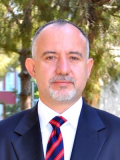Table of Contents
Definition / general | Essential features | Terminology | ICD coding | Epidemiology | Pathophysiology | Etiology | Clinical features | Diagnosis | Radiology images | Prognostic factors | Case reports | Treatment | Clinical images | Gross description | Gross images | Microscopic (histologic) description | Microscopic (histologic) images | Differential diagnosis | Additional referencesCite this page: Özer E, Wasserman B. Beckwith-Wiedemann syndrome. PathologyOutlines.com website. https://www.pathologyoutlines.com/topic/adrenalbeckwith.html. Accessed April 2nd, 2025.
Definition / general
- Beckwith-Wiedemann syndrome (BWS) is an overgrowth syndrome present at birth with certain congenital anomalies and increased risk of pediatric cancer (see OMIM: Beckwith-Wiedemann Syndrome [Accessed 16 October 2017])
- Originally called exomphalos, macroglossia, gigantism syndrome by Dr. Hans-Rudolf Wiedemann in 1964; the combination of congenital anomalies was renamed Beckwith-Wiedemann syndrome by Prof. John Bruce Beckwith in 1969
Essential features
- Macrosomia
- Macroglossia
- Visceromegaly
- Embryonal neoplasms; mainly Wilms tumor and hepatoblastoma
- Omphalocele / exomphalos
- Adrenocortical cytomegaly
- Renal abnormalities
- Neonatal hypoglycemia
Terminology
- Beckwith syndrome
- Wiedemann-Beckwith syndrome
- Exomphalos, macroglossia, gigantism (EMG) syndrome
ICD coding
Epidemiology
- Incidence of 1:13,700 births
- Occurs in a variety of ethnic populations
- M=F
Pathophysiology
- Epigenetic dysregulation of gene transcription within the BWS critical region (imprint domain) on chromosome 11p15 (sporadic):
- Imprinting centers (IC1 and IC2) control gene expression across large chromosomal domains
- Loss of methylation of IC2 (imprinting on the maternal chromosome (50%)
- Paternal uniparental disomy of 11p15 (20%)
- Gain of methylation of IC1 on the maternal chromosome (5%)
- Reference: J Hum Genet 2013;58:402
Etiology
- Most individuals with BWS have normal chromosome studies or karyotypes
- Children conceived by assisted reproductive technology (ART) may have an increased risk for imprinting disorders (Fertil Steril 2005;83:349)
- Imprinted genes, including growth factors and tumor suppressor genes mapping to the 11p15 region, have been implicated
- Duplication, inversion or translocation involving the p15.5 band of chromosome 11 are found in < 1% of affected individuals (familial)
- Approximately 85% of reported BWS cases are sporadic, while the remaining 15% are familial (Am J Med Genet Semin Med Genet 2010;154C:343)
Clinical features
- Macrosomia (height and weight > 97th percentile)
- Macroglossia
- Anterior linear ear lobe creases / posterior helical ear pits
- Anterior abdominal wall defects
- Omphalocele / exomphalos
- Umbilical hernia
- Diastasis recti
- Visceromegaly involving liver, spleen, kidneys, adrenals and pancreas
- Renal abnormalities (nephrocalcinosis, medullary sponge kidney, cystic changes, diverticula, nephromegaly)
- Cytomegaly of fetal adrenal cortex (adrenocortical cytomegaly)
- Embryonal neoplasms (Wilms tumor, hepatoblastoma, neuroblastoma, adrenocortical carcinoma, rhabdomyosarcoma)
- Increased risk for neoplasia occurs in first eight years of life
- This risk is evaluated between 7.5% and 10% (Arch Pediatr 2008;15:1498)
- Hemihyperplasia (asymmetric overgrowth of one or more regions of the body)
- May affect segmental regions of body or selected organs and tissues
- Milder phenotypes may develop tumors associated with BWS
- Pregnancy related findings include polyhydramnios and prematurity
- Reference: Eur J Hum Genet 2010;18:8
Diagnosis
- For all pregnancies at increased risk for BWS, whether or not the genetic mechanism is known:
- Maternal serum alpha fetoprotein (AFP) concentration may be elevated at 16 weeks gestation in presence of an omphalocele
- Obtain ultrasound at 19 - 20 and 25 - 32 weeks gestation to assess growth parameters, detect abdominal wall defects, visceromegaly, renal anomalies and macroglossia
- Postnatal screening for embryonal neoplasms (Am J Med Genet 2016;170:2248, Eur J Med genet 2016;59:52):
- Abdominal ultrasound examination every three months until age 8 years
- Measure serum alpha fetoprotein (AFP) concentration every two to three months until age 4 years for early detection of hepatoblastoma (AFP serum concentration declines in postnatal period at slower rate than in healthy children and may be elevated in first year of life in BWS)
- Low yield: screening for neuroblastoma with periodic chest Xray and urinary VMA and VHA
Radiology images
Prognostic factors
- Historical mortality rate of 20% but may now be improved
- Early death may occur from complications of prematurity, hypoglycemia, cardiomyopathy, macroglossia or neoplasms
Case reports
- 2 month old infant with sudden death (Am J Forensic Med Pathol 2000;21:276)
- 2 month old with antenatal diagnosis of bilateral adrenal cysts at 32 weeks gestation (Afr J Paediatr Surg 2010;7:209)
Treatment
- Directed toward the specific symptoms that are apparent in each individual
Gross description
- Enlarged adrenal glands (up to 16 g) with cerebriform and nodular surface
- Enlarged placenta (2x for gestational age)
- Hepatomegaly with multilobulation
- Placental mesenchymal dysplasia (Pathology 2012;44:519, Arch Pathol Lab Med 2007;131:131)
- Bulky placenta with a "bed of yarn" appearance to maternal surface
- Dilated and thrombosed vessels of chorionic plate
- Resembles partial mole
Gross images
Microscopic (histologic) description
- Adrenal cytomegaly
- Adrenal cortical cells with bizarre, enlarged polyhedral cells with granular eosinophilic cytoplasm and large, hyperchromatic nuclei with pseudoinclusions
- Placental mesenchymal dysplasia
- Dilated and thick walled chorionic plate vessels with fibromuscular hyperplasia
- Hyperplasia of islets of Langerhans in the pancreas
- Cystic tubules in the medullary region of the kidney
- Hyperplasia of the interstitial cells in the ovary
- Nephrocalcinosis
- Diffuse tubular injury with atrophy, interstitial fibrosis and abundant tubular deposition of calcium phosphate
Microscopic (histologic) images
Differential diagnosis
- 11p trisomy (J Genet Hum 1988;36:323)
- Klippel-Trenaunay-Weber syndrome
- Simpson-Golabi-Behmel syndrome (Wikipedia: Simpson-Golabi-Behmel Syndrome [Accessed 16 October 2017])
- Sotos syndrome (cerebral gigantism) (Wikipedia: Sotos Syndrome [Accessed 16 October 2017])
- Weaver syndrome (Wikipedia: Weaver Syndrome [Accessed 16 October 2017])
- Wilms tumor, aniridia, genitourinary defects and intellectual disability (WAGR) syndrome (Wikipedia: WAGR Syndrome [Accessed 16 October 2017])
Additional references













